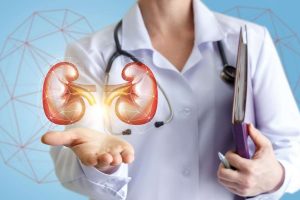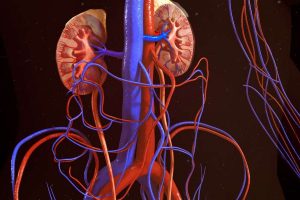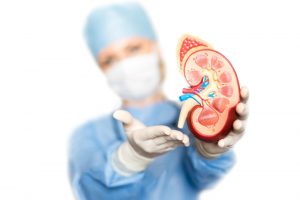The kidney is one of two organs situated in the lumbar region of the back, abdominal wall, just above the waistline. These organs have multiple functional tasks, incorporating waste removal, bone health, electrolyte balance and fluid, stimulation of red blood cell production and acid-base balance, and in short, they are the guardians of the internal environment of the body reworking the fluids in the body fifteen times per day.
The kidney is a complex organ with some essential functions. This complexity is somehow appealing to nephrologists (particularly those with a research interest) but has been a great disincentive for non-specialists to gain an understanding of kidney disease.
For this reason, this chapter will describe the structure and function of the kidneys only as far as they relate to everyday clinical practice Kidney size and shape in the diagnosis of renal disease.
The kidneys lie in the loins (high in the posterior abdomen, adjacent to the vertebral column). The leftward kidney rests higher than the right one because of the presence of the right lobe of the liver. The kidneys are bean-shaped with smooth outlines, and they are usually around l0–l2cm in length.
Renal size relates to the size of the individual, so 9cm-long kidneys may be healthy for a small female but are small for a tall male. For this reason, it is not possible to give a clinically useful ‘normal range’ for renal size. Suffice to say those kidneys of 8cm or less in length are rarely normal.
Assessment of renal size by ultrasound is often desirable at an early stage when assessing patients with abnormal renal function. Renal shrinkage is a characteristic of kidney disease. Adult polycystic kidney disease is the one situation where CKD is associated with kidney enlargement; the finding of renal cysts usually makes this diagnosis obvious.
The renal shrinkage that usually occurs in CKD predominantly affects the cortex rather than the medulla. Specific mention of reduction of cortical thickness in the ultrasound report may, therefore, be helpful in confirming CKD when measurement of overall renal size gives an equivocal impression.
The Kidneys and Their Role in Health
Knowledge is the key to making an exact change in your health. It is just as important to understand why you are doing something as it is to do it. Instead of jumping right into cleansing, start with a basic understanding of the role of kidneys.
If you respect the kidneys for all they do in the body, you’ll want to treat them the way they deserve to be treated. And don’t worry, if you just cringed at the thought of an anatomy lesson, this will be short and sweet.
The Kidneys And How They Work
The kidneys eliminate waste and water from the blood, and they form urine, one of the body’s main ways to rid itself of toxins. But how does waste get into the blood in the first place? It gets into the blood through the normal metabolism of active tissues, such as muscles, as well as from components of foods we eat, such as sugars, food coloring, preservatives, and MSG.
It is necessary to remark that we are using our food as fuel, and so any components that are not good for us are sent directly to the blood as waste. The more junk you eat, the more waste you are forcing your body to deal with. Get it?
If the kidneys are unable to remove this waste, then it builds back up in the blood and damages the body, including the kidneys. It is crucial that our kidneys perform their role efficiently, because just as you do not desire to survive in a home full of waste, neither do your cells.
How exactly do the kidneys remove the waste? The actual process of waste removal occurs inside tiny units in the kidneys called nephrons. Each kidney contains millions of nephrons housing intricate filtering and balancing systems.
Once the waste enters a nephron, it goes into a tiny blood vessel called a glomerulus that intertwines with a urine-collecting tube called a tubule. The glomerulus filters the waste out of the blood, into a collecting duct, and out of the kidney via the ureter to be eliminated through urination.
During this process of filtering waste, many other vital functions are happening as well. Let’s take a quick look at them.
Urine Formation and Blood Cleansing
Through the formation of urine, the kidneys act as one of the primary detoxification organs in the body, expelling about 1-1/2 liters of urine each day. It is one of the most efficient ways for the body to rid itself of toxins and impurities that could otherwise damage the blood and lead to bodywide dysfunction.
The formation of urine involves filtration, reabsorption, and secretion. To remember this process, think of FRS (or my mnemonic, first-rate secretor).
This is where the body chooses the nutrients it needs to keep and what it must get rid of. Check out the “No Dialysis Needed” program is a step-by-step treatment program which helps improve your kidneys naturally, without the use of unnatural man-made pharmaceutical drugs.










